
The Basics - Getting Started June 20, 2001
Keyframing in Final Cut Pro
Green is the Color of KeyframeBy Ken Stone

The Basics - Getting Started June 20, 2001
Keyframing in Final Cut Pro
Green is the Color of KeyframeBy Ken Stone
What is a Keyframe?
When we set a 'Keyframe' in FCP, which we set on a specific video frame either on the TL (Timeline), in the Viewer, or Canvas windows, we are 'marking' that video frame as the starting place for something to begin changing. When we set a second Keyframe, further down the line, we are marking that video frame as the place were we want the change to be complete. FCP will interpolate or generate all the frames needed between the 2 Keyframes so that the change will happen smoothly, over time.
Well, in FCP almost everything can be Keyframed. Some of the effects that we can Keyframe are: filters - color, size, opacity, rotate, mattes, masks, blurs, composites and change from color to Black and White. The only filter that can not be Keyframed is the,' de-interlace' filter. We can place any number of Keyframed filters on a clip and have them all running at the same time, all changing independently of each other. Very powerful stuff.
There are almost as many ways to apply Keyframes and work with them as there are things that can be Keyframed. We will start by doing our work in the Viewer window. We are going to change a video clip from color to black & white and then back to color again, over time.
I like to use the 'Sepia' filter which is found in the Image Control folder in the Effects browser. Drag and drop the Sepia filter from the Effects browser onto the clip in the TL. Double click on the clip in the TL to load the filter into the Viewer window and click on the Filters tab.
The first thing you will notice is that the Sepia filter default setting is set to 100 in the Amount box (Red Arrow). The Amount box controls the amount of filter that is applied to the clip. 100 being full filter effect, 0 being no filter effect. To the right of the Amount box you will first see the Keyframe button. Further to the right is the TL. In the TL you will see a horizontal green line. This is what I call the Keyframe line. You will notice that it is all the way at the top of the space as the filter amount is still set to 100. You can click on this Keyframe line and drag up or down to change the amount of the filter that is applied but this will effect the entire clip. The 'Red X' button under the word 'Nav' is the reset button and will return the filter to it's default settings.
What can be Keyframed?
Keyframing

Hey, it's Sepia, well okay double click on the 'Color' box to get the color wheel (Sepia arrow above). Move the slider all the way to the left to 0. Now it's Black, hit okay. The image in your Canvas window should now be B & W. Our image is B & W because the Sepia filter defaults to 100 filter applied.
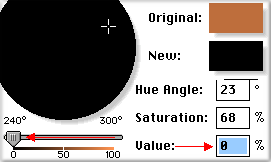
What we'll be doing is running our filter from 0 (no effect) to 100 (full effect) over time. The start time and end time will be determined by where we place our Keyframes on the TL. As I want my clip to start off in color, zero filter applied, I will enter 0 into the Amount box (Red arrow) and hit enter. You will notice that the green Keyframe line has dropped to the bottom of the space in the TL. The White arrow points to a thin white vertical line which denotes the end of the clip. I want the clip to run in color for awhile before I start the filter, so I have moved the Playhead down the TL to my start point. My filter has been set to Black, the Playhead is in position and Amount is 0. Now I am ready to set my first Keyframe. Click on the Keyframe button and two things happen; first the button turns green showing that a Keyframe has been set, second, the Keyframe itself has been set on the TL (Green arrows below).

I now move my Playhead further down the TL to the point that I want my filter to be full on, amount of 100. I enter the amount of 100 in the Amount box and hit enter. FCP detects the change and automatically sets a new, second Keyframe on the TL. You can see that the green Keyframe line now runs up to the second Keyframe. FCP will interpolate all the frames between the two Keyframes and the clip will change from full color to B & W over the amount of time between the two Keyframes.

At this point my clip is now B & W (amount 100) and I want it to become full color again. As I want the clip to run in full color for a short time before the clip ends I now move my Playhead further down the TL but not to the end of the clip. With my Playhead in position, I enter 0 into the Amount box and FCP sets my third Keyframe. The green Keyframe line runs back down to the to the third Keyframe which has a value of 0.

Now that my Keyframes have been set I want to preview the work. I make the TL active, turn off snapping, hold down the option key and scrub through the clip by dragging the Playhead.
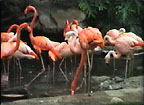


While scrubbing through the clip I discovered that I don't like the full on B & W, too harsh. Moving my Playhead off the second Keyframe, filter amount of 100, I found a frame that has a hint of color and is less harsh. Back in the Viewer, Filter tab, with the Playhead on my good frame, I look at the Amount box and see that the amount is 82.45. This the amount that I want to use. I move my Playhead back to the second Keyframe and enter 82.45 into the box and enter. The second Key now moves down to the new setting. If you will look to the left and right of the Keyframe button (Black arrow) you will see to triangle buttons. Clicking on these will move the Playhead either to the previous Keyframe or next Keyframe.


We have been working our Keyframes using the Amount box and the Playhead, but FCP is much more flexible. If you place your Cursor on top of a Keyframe you will see that it turns into a + or move tool. You can click on the Keyframe and drag it up or down, increasing or decreasing the amount of filter applied, or forward or backward on the Keyframe line changing the position in time, sooner or later. You can add a Keyframe at any point on the green Keyframe line by selecting the 'Pen' tool and clicking on the line. You can delete a Keyframe by holding down the Option key, the Pen tool will turn into a - (minus) sign, click on a Keyframe to remove.
Keyframes can cause abrupt changes in velocity at the Keyframe points (below left). Control click on a Keyframe and select 'smooth'. This will apply a set of 'Bezier' handles to the Keyframe which you can drag to smooth the Keyframe point and change the velocity (below right). While using 'smooth' will even out the Keyframe change, it in no way changes the timing of Keyframes. The amount of time between the Keyframes will remain the same.


Keyframing in the Canvas window
I want my image to start small and grow large 'over time' until the end of the clip where it will be full sized. In the Canvas window, set to 'image + wireframe' and click inside the Canvas to make it active. I place my Playhead at the beginning of the clip making sure that I am on the first frame by looking for the 'first frame marker'.
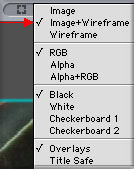

Clicking on a corner of the Turquoise Bounding box, below left, I drag into the center to reduce the size of the picture until it's the size I want. With the Playhead at the first frame and my image sized, I set a Keyframe by clicking on the Keyframe button at the bottom of the Canvas window, below center. After I have set my Keyframe the wireframe 'X' has turned green denoting a Keyframe, pictured on right. Only certain motion properties can be Keyframed from the Canvas window. If you Control click on the Keyframe button at the bottom of the Canvas window you will see a drop down list of those items are are available for Keyframing. You can select any number of these items from the drop down menu. The Keyframable properties from the Canvas window are: Scale, Rotation, Center, Anchor Point, Aspect Ratio, Crop, and Distort.
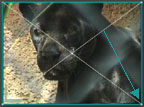

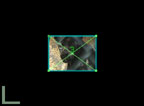
Now I need to move to the end of the clip to set my second Keyframe. Again I must stress that you need to check to see that you are actually on the last frame of the clip and NOT on the Edit point. Use your arrow keys to move to the last frame if you are not already on it.

Last frame marker |

Edit point |
My Playhead is now in place, I need to enlarge the image by clicking on a corner of the Bounding box and dragging out. I then set a Keyframe (wireframe turns green). Option scrub to preview.
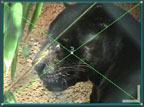
The Motion Tab
Of course all this can be done in the Viewer's Motion tab. While there are times that you will want to work Keyframes in the Canvas, the Motions tab offers a lot of advantages. The Motions window consolidates a number of effects that are often used in combination: Scale, Rotation, Center, Crop, Distort, Opacity, Drop Shadows, and Motion Blur. All of these effects sit one below the other in the Motions window. This makes it much easier to coordinate Keyframing as the TL and Keyframes for all effects are right there together. In addition the Motion window can be separated from the Viewer by clicking on the tab and dragging out of the Viewer. The Motion window's TL can be extended out to the right by clicking on the lower right hand corner of the window and dragging. The Motion window can be returned to the Viewer window by simply closing it.
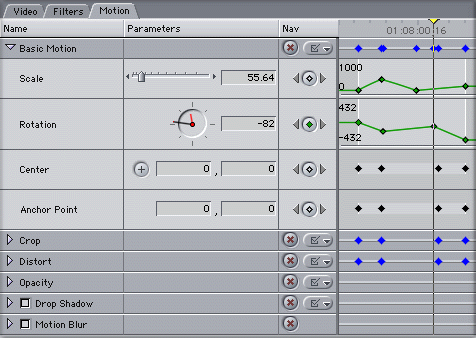
Keyframing on the TL
In the TL I have a clip that I want to modify the volume in different places, decrease and then increase the volume. At the end of the clip I want to fade the audio out. I also want the opacity of the clip to fade down at the end of the clip to match the fade of the audio.
 Enlarge the TL so that you have some room to work. Turn on 'clip overlays' from the lower left hand side of the TL (Pink arrow at right). You will now have horizontal lines running the length of your clip in both the video track, in black and audio tracks are pink . These 'clip overlays' are what we will work on to achieve the desired results.
Enlarge the TL so that you have some room to work. Turn on 'clip overlays' from the lower left hand side of the TL (Pink arrow at right). You will now have horizontal lines running the length of your clip in both the video track, in black and audio tracks are pink . These 'clip overlays' are what we will work on to achieve the desired results.

Select the 'pen' tool from the tool palette or hit 'p' on the keyboard. With the pen tool selected find the location on the TL where you want to lower your audio, you will set 2 Keyframes just before the part of the audio you want to change and 2 Keyframes just after this point. So far we have set Keyframes but have not made any changes. Place your cursor on the overlay line between the two sets of Keyframes and click and drag down. As you do this you will get a small yellow box that notes the amount of audio change in dBs. -2, -6, -12. To raise the volume back up later in the TL set another Keyframe at the desired point and pull the overlay back up.
We will click on the video overlay line and set a Keyframe where we want our opacity to start fading down to match the fade down in the audio. At the end of the clip we will set another Keyframe on the video overlay where we want our fade to end and then pull it down. We now have video and audio fading down to black at the end of the clip. It should be noted that the only two effects that can be Keyframed in the TL are audio and video. These TL overlay lines are often referred to as 'rubberbands'.


As I said at the top of this article there are many ways to use Keyframes. Keyframes are all about video changing over time. While it may seem a bit complicated at first, Keyframes are very straight forward and you soon will be able to accomplish the effects that you want. Hey, these are moving pictures, make them move.
Enjoy,
--ken
copyright © Ken Stone 2001